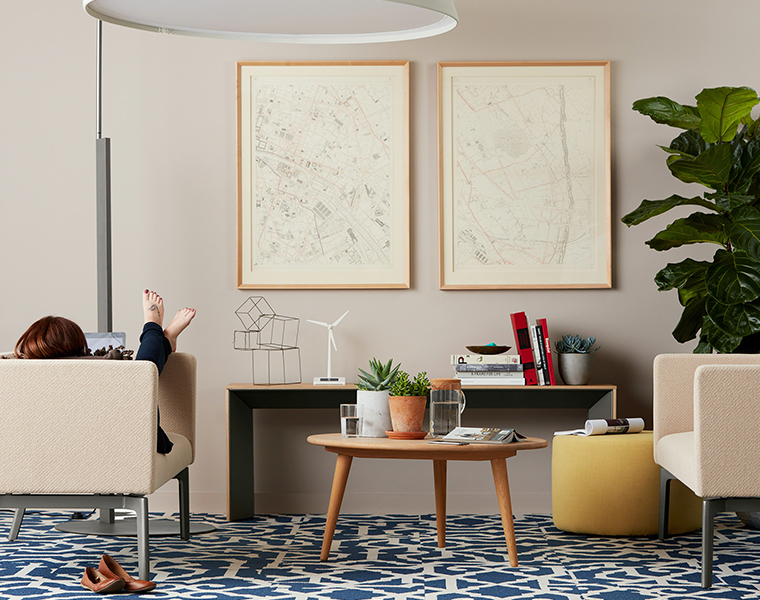Did you know that in 2015, a record 17 million working days were lost due to stress, anxiety and depression, costing the economy a record £2.4billion?
It’s statistics like these, reported by the UK Statistics Authority, that show exactly why well-being in the workplace is no longer just nice to have; it’s essential. When creating a healthy office space for your staff, it is important to consider the physical, emotional and cognitive aspects of wellbeing.
Physical wellbeing
Assessing the physical aspects of wellbeing is all about looking at how staff can physically work better. We need to keep moving to keep healthy.
In recent years, there has been an emergence of ergonomic products with increased options for movement throughout the working day. Office chairs have changed dramatically over the years and one of the most impressive new designs to emerge is the Gesture chair.
The pioneering Gesture chair is inspired by the human body and the first of its kind to be designed to support our interactions with today’s technologies.
The product was created in the wake of a posture study by US manufacturer Steelcase, which analysed 2000 people across 11 countries, observing participants in a wide range of postures. It discovered that nine new postures, developed as a result of new technologies and behaviours, were not being adequately addressed by existing seating solutions. And the Gesture Chair was born.
Aside from seating, the Sit & Stand desk is generating much interest in workplaces across the UK.
These height adjustable desks are extremely versatile and flexible, giving users the opportunity to increase their movement with ease. Available in a number of finishes, with fingertip height controls, monitor arms to keep PCs from cluttering desk space and cable management trays, they are a fresh and modern way for staff to work.
Emotional wellbeing
It is important to consider the emotional state and mental wellbeing staff when creating a work environment as this is all about how your staff feel. Done well, your staff will be highly engaged with the business and enjoy coming to work.
When in a positive state of mind, studies show that individuals are more collaborative, creative and open to exploring new ways of doing things. As a business, you will naturally depend on staff to be in this positive state of mind for them to be at their most productive.
But how can you ensure that they are? Consider the following:
- Take inspiration from home comforts to help cultivate a comfortable environment and sense of belonging. Increasingly, businesses are seeing the value in incorporating elements of well-being into the workplace, as this helps to reinforce the message that staff don’t need to leave the office to switch off. The boundaries between home and work life have blurred, with trends in office design seeing big rugs, warm lighting and natural wood furnishings become more popular.
- The so-called ‘third space’ is an emerging design concept and businesses of all sizes are seeing the benefit. Social connections are important to cultivate a sense of belonging and engagement at work, and it is beneficial to create a café culture within the workplace itself, rather than having staff seek this elsewhere. If you are looking to create a community feel in the workplace, you must create spaces that portray this.
- Create spaces for people to switch off and take time out. Introducing these areas in the office gives staff a place to rejuvenate and bounce back more productive as a result. Many businesses today are choosing to implement a Work Café; a dynamic space that connects staff with their colleagues, their own work and the business as a whole.
Think Better
This is all about cognitive wellbeing and how to ensure that staff are mentally prepared to be at their best, when distractions are more prevalent than ever. Over the last decade or so, workplaces have changed beyond all recognition, and much of this is down to technology.
The University of California estimates that the average office worker is now interrupted or distracted every 3 minutes, and it takes an average of 23 minutes to return to a task after being interrupted, says the same university.
But how can we concentrate when there are so many distractions? Global entertainment corporation Mashable reports that a staggering 204 million emails are sent every minute, and more people than ever are connected to their mobile devices, both in and out of the office. It is important to have areas within the workplace that people can relax and rejuvenate, but also seek privacy.
Consider the following:
- Create areas in the office for collaboration. Collaborative environments encourage staff to bounce ideas off each other, work as a team, boost creativity and foster a culture of working together to achieve great things.
- Give your staff privacy when they need it. Head stuck in a tricky project? Need to focus? We’ve all been there – providing staff with spaces for uninterrupted work will help them to concentrate and think clearer.
- Take a look at the format of your meetings. Are they lengthy? As productive as they can be? Innovative products such as Clickshare are revolutionising meetings by allowing your team to work seamlessly from one screen. Set up is quick and it’s really easy to use, with the option to connect up to 8 people in one meeting.


